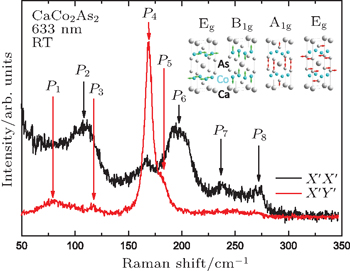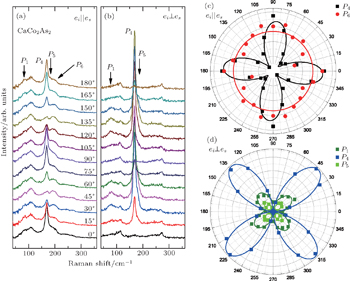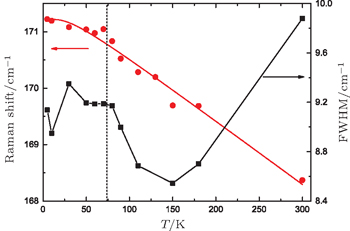† Corresponding author. E-mail:
Project supported by the National Basic Research Program of China (Grant No. 2012CB921701), the National Natural Science Foundation of China (Grant No. 11474357), and the Fundamental Research Funds for the Central Universities, and the Research Funds of Renmin University of China.
In this work, Raman scattering measurements have been performed on the collapsed phase CaCo2As2 crystals. At least 8 Raman modes were observed at room temperature though CaCo2As2 is structurally similar to other 122 compounds like BaFe2As2. Two Raman modes are assigned to the intrinsic A1g and B1g of this material system respectively. The other ones are considered to originate from the local vibrations relevant to cobalt vacancies. Careful polarized measurements allow us to clearly resolve the four-fold symmetry of the B1g mode, which put strong constraints on possible point group symmetries of the system with Co vacancies. The temperature-dependent measurements demonstrate that the anomalies in both frequency and width of the B1g mode occur around Neel temperature TN. The anomalies are considered to be related to the gap opening near the magnetic transition. The study may shed light on the structural and magnetic changes and their correlations with superconductivity in 122 systems.
The ThCr2Si2-type compounds have attracted a tremendous amount of attention since the discovery of iron-based superconductors in 2008.[1,2] Besides iron pnictides, many other 122 systems have also been extensively studied. Superconductivity was found in CaPd2As2 (Tc ∼ 1.27 K) and SrPd2As2 (Tc∼ 0.92 K) single crystals.[3] A checkerboard antiferromagnetic (AF) structure was observed in insulating BaMn2As2 and relevant compounds.[4,5] Itinerant antiferromagnetism was reported in BaCr2As2.[6,7]
Cobalt-based 122 compounds are closely similar to 122 iron pnictides in many aspects. However, no superconductivity was measured in the doped SrCo2As2.[8] However, a clear negative thermal expansion was observed in the compound.[9] CaCo2As2 has received particular interest among the cobalt-based 122 compounds. It has a typical ThCr2As2 structure (space group I4/mmm) and a small ratio of c/a ∼ 2.59 under ambient pressure, suggesting a collapsed phase,[10,11] just as was found in CaFe2As2. A range of external pressures can reduce its c axis by a factor of ∼ 9.5% and drive a collapsed phase transition[12,13] with no magnetic[12–15] or superconducting[16] transition. Similar to the AF transition at ∼ 170 K in CaFe2As2, A-type AF ordering in CaCo2As2 was also observed by different research groups. The reported TN ranges from 70 K to 76 K.[17,18] It increases to 90 K with 10% Sr doping.[17] Interestingly, a spin flop transition was observed in all the above measurements.[17,18] However, if Sn instead of CoAs is used as flux, the crystals have a TN of only ∼ 52 K and 7% Co vacancies.[19,20] It is unclear if the reduction of TN is related to Co vacancies and the issue remains an open question so far. As one of the fundamental techniques sensitive to crystal microstructures, Raman scattering has been proved to be an effective way to probe vacancies and their ordering.[21]
Raman scattering measurements on CaCo2As2 were carried out in this work. At least 8 modes were observed, which is much more than the number of symmetry-allowed Raman modes. Polarized Raman measurements indicate that three of the modes have a four-fold symmetry and one has a full-symmetry. The temperature-dependent Raman spectra reveal that the strongest peak shows clear anomalies in both frequency and width near the AF transition. This is similar to the cases of 122 and 11 iron pnictides and provides the important information on vacancies in the material. The present study may provide insight into superconductivity, magnetism and collapsed phase because of the close similarity between CaCo2As2 and other 122 systems including the superconducting ones.
The CaCo2As2 crystals used in the work were grown through the self-flux method that has been described in detail elsewhere.[13,22] Structural and thermodynamic characterizations can be found in Ref. [20]. Raman measurements were performed using a Jobin Yvon HR800 single-grating system equipped with a liquid-nitrogen cooled CCD detector and a He–Ne laser source of 632.8 nm (Melles Griot). A backscattering configuration was adopted in all the measurements. The laser power was controlled at the level of ∼ 1 mW and the laser spot was ∼ 5 μm in diameter. The cleaved surface was parallel to the ab-plane and the incident light is perpendicular to the surface or parallel to the c axis. X′X′ denotes that the polarizations of both incident and scattering light are parallel to the diagonals between a and b axes, while X′Y′ means that their polarizations are orthogonal. Polarized Raman measurements were made at room temperature by fixing the perpendicular polarizations between incident and scattering light and rotating crystal at a step of 15°. The space and point groups of CaCo2As2 are I4/mmm and D4h respectively, which allows 4 Raman-active modes including one A1g mode, one B1g mode, and doubly degenerate Eg mode (see the inset of Fig.
Figure
 | Fig. 1. Polarized Raman spectra collected at room temperature. The inset shows the vibration patterns of four Raman-active modes in 122 system. |
We further made polarized Raman measurements by rotating crystals to resolve mode symmetries. The spectra are shown in Figs.
The temperature-dependent Raman spectra are shown in Fig.
In summary, Raman scattering studies of collapsed phase CaCo2As2 have been made in this work and at least 8 peaks are observed. Two of them are assigned as intrinsic A1g and B1g modes, and the other ones are considered to come from the local vibrations induced by Co vacancies. Polarized Raman measurements determine the four-fold symmetry of the system, which put strong constraints on the possible patterns of Co vacancies. Further temperature-dependent experiments reveal that the anomalies of B1g mode in width are related to the AF transition through a spin-phonon coupling.
| 1 | |
| 2 | |
| 3 | |
| 4 | |
| 5 | |
| 6 | |
| 7 | |
| 8 | |
| 9 | |
| 10 | |
| 11 | |
| 12 | |
| 13 | |
| 14 | |
| 15 | |
| 16 | |
| 17 | |
| 18 | |
| 19 | |
| 20 | |
| 21 | |
| 22 | |
| 23 | |
| 24 | |
| 25 | |
| 26 | |
| 27 |





